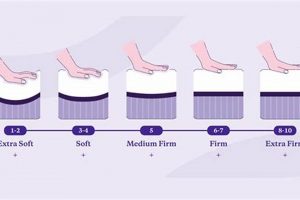The variation in mattress feel, specifically comparing a yielding, soft surface to one offering significant resistance, is a primary factor in determining sleep comfort. One option provides a cradling sensation, allowing the sleeper to sink into the material, while the other maintains a more rigid, supportive plane. This fundamental distinction influences spinal alignment, pressure point relief, and overall sleep experience.
Selecting the appropriate mattress firmness is crucial for achieving restorative sleep and minimizing discomfort. Individual preferences, sleeping positions, and body weight all play a significant role in determining the optimal choice. Historically, mattress construction has evolved significantly, with advancements in materials and engineering leading to a wider range of firmness options catering to diverse needs.
This article will explore the characteristics of these two primary mattress types, examining their construction, suitability for different sleepers, and the advantages and disadvantages of each. Understanding these aspects is essential for making an informed decision when selecting a mattress.
Guidance on Mattress Selection
Selecting a mattress requires careful consideration of individual needs and preferences. The following guidance aims to provide a structured approach to choosing between mattress options based on their relative firmness.
Tip 1: Body Weight Assessment: Individuals with a higher body mass may find greater support and spinal alignment with a firmer sleep surface. Conversely, those with lower body mass may prefer a softer surface to avoid pressure point discomfort.
Tip 2: Sleep Position Analysis: Side sleepers often benefit from a plusher mattress that allows the shoulder and hip to sink in, promoting spinal alignment. Stomach sleepers typically require a firmer surface to prevent excessive sinking of the midsection, which can lead to back pain. Back sleepers may find comfort on either type, depending on personal preference and spinal support needs.
Tip 3: Pressure Point Sensitivity Evaluation: Individuals experiencing pressure point pain, such as in the shoulders or hips, may find relief with a yielding mattress. The conforming nature of a softer surface can distribute weight more evenly and reduce pressure concentration.
Tip 4: Spinal Alignment Considerations: Proper spinal alignment is crucial for preventing back pain and promoting restful sleep. It’s advisable to test mattress firmness by lying down in one’s preferred sleeping position and assessing whether the spine maintains its natural curvature.
Tip 5: Trial Period Utilization: Many mattress retailers offer trial periods. Taking advantage of this opportunity allows for extended testing in a real-world sleep environment, facilitating a more informed decision.
Tip 6: Consultation with Professionals: Seeking guidance from a chiropractor or physical therapist can provide personalized recommendations based on specific musculoskeletal conditions or concerns.
These guidelines emphasize the importance of aligning mattress selection with individual physiological needs and sleep preferences. By carefully evaluating these factors, one can significantly improve sleep quality and overall well-being.
The subsequent sections will delve into the construction and materials commonly used in manufacturing mattresses of varying firmness levels.
1. Support Core Density
Support core density is a primary determinant of mattress firmness, directly impacting the overall sleep experience. The material composition and arrangement within the core dictate the degree of resistance and support offered, thereby differentiating between mattress types.
- Material Composition and Firmness
The type of material used in the support core significantly influences its density and resulting firmness. High-density foam, for example, provides greater resistance to compression than lower-density alternatives. Similarly, tightly coiled innerspring systems offer more substantial support compared to loosely constructed ones. The choice of material fundamentally establishes the baseline firmness level of the mattress.
- Density and Weight Distribution
A higher density core facilitates more even weight distribution across the mattress surface. This reduces pressure points and minimizes the likelihood of sagging or indentation over time. Conversely, a lower density core may concentrate weight in specific areas, leading to localized discomfort and a diminished lifespan for the mattress. The ability to distribute weight is a critical attribute for maintaining spinal alignment and preventing pain.
- Impact on Spinal Alignment
Support core density plays a pivotal role in promoting proper spinal alignment during sleep. A firmer, higher-density core can prevent excessive sinking, particularly in the hip region, which is essential for maintaining a neutral spinal posture for back and stomach sleepers. A core with inadequate density may allow the spine to curve unnaturally, potentially exacerbating back pain and discomfort.
- Durability and Longevity
Mattresses with high-density support cores tend to exhibit greater durability and longevity. The denser materials are less susceptible to compression and degradation over time, maintaining their supportive properties for a longer period. Lower-density cores are more prone to softening and sagging, which can compromise comfort and necessitate more frequent replacement.
In summary, support core density is a crucial factor in differentiating mattresses. A high-density core generally correlates with a firmer mattress, offering enhanced support, improved spinal alignment, and increased durability. The reverse holds true for plush mattresses, where lower density cores prioritize comfort and pressure relief, albeit potentially at the expense of long-term support and longevity.
2. Surface Layer Composition
The outermost layers of a mattress significantly influence its initial feel and contribute substantially to the differentiation between models. Material selection and construction techniques in these layers determine the degree of comfort, pressure relief, and temperature regulation experienced by the sleeper. Understanding the composition of these layers is essential for discerning the nuances between various support options.
- Foam Density and Type
The density and type of foam used in the surface layers directly correlate with the level of conforming comfort. High-density memory foam, for example, exhibits a slow response and deep compression, contouring closely to the body. This characteristic is prevalent in plusher models seeking to minimi
ze pressure points. Conversely, firmer mattresses may utilize high-density polyfoams that offer less give, providing a more supportive and stable surface. - Quilting and Padding
Quilting patterns and the type of padding materials employed contribute to the overall surface texture and perceived softness. Thick quilting with fibers like polyester or wool creates a plusher initial feel, often found in models designed for comfort. Minimal quilting or the use of denser materials, such as tightly woven fabrics, results in a firmer surface with less immediate cushioning.
- Fiber Content and Arrangement
The inclusion and arrangement of natural or synthetic fibers within the surface layers impacts breathability and temperature regulation. Materials like cotton or wool promote airflow and moisture wicking, enhancing comfort and reducing heat buildup. The density and layering of these fibers influence the overall surface feel, with looser arrangements contributing to a plusher sensation and tighter configurations resulting in a firmer feel.
- Material Response Time
The responsiveness of the surface materials to pressure variations is a key factor in determining the perceived firmness. Slow-responding materials, such as memory foam, allow the sleeper to sink into the mattress, providing enhanced pressure relief and a plusher feel. Faster-responding materials, like latex, offer immediate support and a more resilient surface, contributing to a firmer feel.
In conclusion, the composition of the surface layers plays a critical role in shaping the characteristics. The interplay of foam density, quilting, fiber content, and material responsiveness directly dictates the balance between conforming comfort and firm support. This balance is a defining factor.
3. Pressure Point Relief
The degree to which a mattress alleviates concentrated pressure on specific areas of the body, particularly the shoulders, hips, and back, defines its capacity for pressure point relief. This attribute is intrinsically linked to the firmness level. Mattresses that yield more readily to body weight, typically categorized as “plush,” tend to distribute pressure over a wider surface area, reducing the intensity of stress on prominent joints and bony structures. Conversely, mattresses with a firmer surface offer less give, resulting in greater pressure concentration at these points. An individual with arthritis, for example, might find a more yielding mattress provides better pressure relief and reduces pain during sleep compared to a firmer option. The ability to mitigate pressure concentration is a fundamental component differentiating varying firmness.
The selection of an appropriate level of firmness to maximize pressure relief requires careful consideration of sleeping position and body weight. Side sleepers, who experience concentrated pressure on the shoulder and hip, often benefit from mattresses that allow these areas to sink in slightly, promoting spinal alignment and reducing discomfort. Back sleepers may find that mattresses offering a balance between support and pressure relief are optimal, maintaining spinal curvature while minimizing stress on the lower back. Stomach sleepers generally require a firmer surface to prevent excessive sinking of the midsection, which can exacerbate pressure on the lumbar spine. The practical application of this understanding lies in enabling consumers to make informed choices that align with their specific physiological needs and preferences, promoting improved sleep quality and reduced pain.
In summary, pressure point relief is a critical consideration. Mattresses mitigate concentrated pressure, which reduces pain and enhances sleep quality. The connection is mediated by surface give, weight distribution, and the match between firmness and the individuals physiological characteristics. While plusher mattresses generally offer greater pressure relief due to their yielding nature, the ideal choice is highly dependent on the sleeper’s body type and typical sleep posture. Ignoring this connection can lead to discomfort, disrupted sleep, and potential musculoskeletal issues.
4. Spinal Alignment Impact
Spinal alignment is fundamentally affected by mattress firmness. A surface failing to maintain the spine’s natural curvature can induce or exacerbate musculoskeletal issues. The selection between mattresses involves considering how each option interacts with the body’s anatomical structure. Plush mattresses allow for greater sinking, potentially suitable for side sleepers where the shoulder and hip need to be accommodated to keep the spine aligned. Conversely, firm mattresses resist compression, offering greater support and potentially preventing excessive sinking for stomach and back sleepers. Improper spinal alignment during sleep can manifest as lower back pain, neck stiffness, and restricted breathing.
The impact on spinal alignment dictates the long-term health of the musculoskeletal system. For instance, a side sleeper utilizing a firm mattress may experience increased pressure on the shoulder and hip, leading to discomfort and potential misalignment. A stomach sleeper on a plush mattress may experience excessive sinking of the abdomen, creating an unnatural spinal curve and resulting in lower back pain. The significance of this extends beyond immediate comfort; chronic misalignment contributes to degenerative disc disease, nerve impingement, and reduced overall physical function. A proper selection, therefore, serves a preventative function, mitigating the risk of future health problems.
In summary, the degree to which a mattress supports and maintains the spine’s natural curvature is a crucial factor in differentiating between mattress types. The interaction between mattress firmness, sleeping position, and individual body structure defines the ultimate impact on spinal health. Understanding this relationship is pivotal for mitigating musculoskeletal issues and promoting restorative sleep. The proper choice is not merely about comfort but about proactively supporting long-term spinal well-being.
5. Sleep Position Suitability
Sleep position directly correlates with the optimal level of mattress firmness needed to maintain spinal alignment and minimize pressure points. Individual sleeping preferenceswhether side, back, or stomachnecessitate different support characteristics from a sleep surface. A mattress ill-suited to a particular sleep position can induce or exacerbate musculoskeletal discomfort, leading to restless sleep and chronic pain. For example, a side sleeper on a firm mattress may experience concentrated pressure on the shoulder and hip, disrupting sleep, while a stomach sleeper on a soft mattress may find their spine is improperly aligned, resulting in lower back pain. Therefore, the selection requires a direct evaluation of these factors.
Considering specific sleep positions and their corresponding needs reveals the practical significance of mattress firmness. Side sleepers generally benefit from a yielding surface that allows the shoulder and hip to sink in, promoting spinal alignment. Plush mattresses often fulfill this requirement
due to their ability to conform to the body’s contours. Back sleepers may find a medium-firm surface provides an optimal balance of support and cushioning, maintaining the spine’s natural curvature without excessive sinking. Stomach sleepers typically require a firmer surface to prevent the midsection from sagging, which can lead to hyperextension of the lumbar spine. These observations highlight the importance of selecting a mattress that complements, rather than contradicts, one’s preferred sleep posture.
In summary, the relationship between sleep position and mattress firmness is a cornerstone of sleep quality and musculoskeletal health. Selecting a mattress that aligns with one’s dominant sleep position is essential for promoting proper spinal alignment, minimizing pressure points, and preventing discomfort. Failure to consider this connection can lead to chronic pain, disrupted sleep, and reduced overall well-being. Understanding the specific needs dictated by each sleep position allows individuals to make informed decisions that support restorative and healthful sleep.
Frequently Asked Questions About Mattress Firmness
The following questions address common concerns and misconceptions regarding mattress firmness, focusing on differentiating characteristics and suitability for various sleep needs.
Question 1: What defines the difference between firm and plush mattress categories?
The primary distinction lies in the degree of surface compliance. Models exhibiting greater resistance to compression and minimal sinking are classified as firm. Models offering a more yielding surface, allowing for greater body contouring, are considered plush. This differentiation influences spinal support, pressure point relief, and overall sleep experience.
Question 2: How does body weight influence the appropriate firmness?
Individuals with higher body mass typically require firmer mattresses to ensure adequate support and prevent excessive sinking, which can compromise spinal alignment. Lighter individuals may find plusher mattresses more comfortable, as these surfaces provide greater pressure relief and conforming support.
Question 3: Does sleep position dictate firmness preference?
Yes, preferred sleep position is a significant factor. Side sleepers often benefit from plusher mattresses that accommodate the shoulder and hip, maintaining spinal alignment. Stomach sleepers generally require firmer mattresses to prevent excessive sinking of the midsection. Back sleepers may find comfort on either firmness level, depending on individual preferences and support requirements.
Question 4: What role does mattress construction play in determining firmness?
Mattress construction directly affects firmness. High-density support cores provide greater resistance, contributing to a firmer feel. The composition and thickness of the comfort layers, including materials like memory foam or quilting, influence the surface feel and overall compliance.
Question 5: Are there disadvantages associated with extremely firm mattresses?
Extremely firm mattresses may concentrate pressure on specific areas of the body, potentially leading to discomfort and disrupting sleep. Individuals with joint pain or pressure point sensitivity may find these mattresses unsuitable.
Question 6: How can one accurately assess firmness levels before purchasing a mattress?
Ideally, extended in-store testing is recommended. Lie in one’s preferred sleeping position and assess whether the spine maintains its natural curvature. If in-store testing is not possible, examine the mattress specifications. It should indicate a scale from 1 to 10, with 1 being plush and 10 being very firm. Additionally, thoroughly review the manufacturer’s return policy, which will allow for at-home testing.
In summary, selecting the appropriate mattress firmness is a personalized decision requiring consideration of body weight, sleep position, and individual comfort preferences. Consulting with a healthcare professional or sleep specialist is advisable for individuals with specific musculoskeletal conditions.
The subsequent section will delve into the materials commonly used in the construction of mattresses and their impact on firmness and overall performance.
The Importance of Understanding Firmness Options
The preceding discussion underscores the critical distinctions defining the differences in firmness. This exploration highlights the influence of support core density, surface layer composition, pressure point relief, spinal alignment impact, and sleep position suitability on selecting an appropriate sleep surface. These factors, when considered holistically, enable informed decision-making regarding mattress selection.
Given the significant impact of mattress firmness on sleep quality and musculoskeletal health, individuals should prioritize careful evaluation when making a purchase. Consulting with healthcare professionals and thoroughly testing options are recommended to ensure long-term comfort and well-being. Selecting the proper firmness level represents an investment in health, facilitating restorative sleep and supporting optimal physical function.







